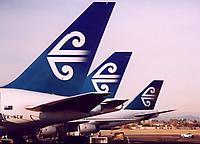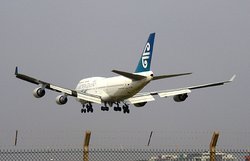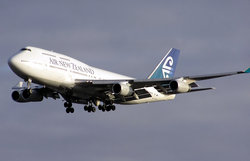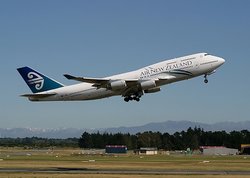Air New Zealand Information
Home > New Zealand Information > Air New Zealand Information
Air New Zealand
From Wikipedia, the free encyclopaedia
Air New Zealand is a major scheduled passenger airline based in New Zealand. It has a considerable international and domestic network.
Code Data
- IATA Code: NZ
- ICAO Code: ANZ
- Callsign: New Zealand
History
Beginnings as TEAL
Originally named TEAL (Tasman Empire Airways Limited), Air New Zealand's first ever flight was on April 30, 1940, with a Shorts Empire Class flying boat carrying 10 passengers from Auckland to Sydney. Registered ZK-AMA and named "Aotearoa", the lumbering aircraft took around 7 hours 30 minutes to travel the 1345 miles between the two cities.
On March 31, 1941, TEAL's first annual report revealed that 130 transtasman flights had been completed, 174,200 miles flown and 1461 passengers carried, with a profit of £3l,479 ($62,958).
During the years of WW2, TEAL undertook several special charter and reconnaissance flights to New Caledonia, Fiji, Tonga, Samoa and Hawaii to assist the war effort. In June 1944, TEAL crossed the Tasman Sea for the 1000th time. In 1947, a competitor appeared in the form of the National Airways Corporation (NAC), which was Government-owned. NAC also provided certain international services to some nearby South Pacific countries.
TEAL's initial schedule of two weekly flights from Auckland to Sydney was soon expanded to add departures from Wellington, and flights to Fiji were also added during the early years.
1953 brought a big step for TEAL when the Australian Government bought 50 percent of the company, with the New Zealand Government deciding to pick up the rest of the airline. This move enabled the company to keep on flying. In 1954, TEAL added the Douglas DC-6 to their fleet, and the landplane replaced the outdated flying boats on most international services. The flying boats operated their last services in 1960. In 1955, TEAL made their 10,000th Trans-Tasman crossing.
In 1959, TEAL again changed their fleet, replacing the DC6 with Lockheed Electra. The turboprop aircraft was capable of carrying 71 passengers at nearly 400 miles per hour, and reduced flying time on the Auckland to Sydney route to just 3 hours 50 minutes.
In 1961, as the airline had become a successful company, the New Zealand Government bought out the Australian Government's half ownership, and on April 1, 1965, the airline was renamed Air New Zealand.
Air New Zealand
The 1960s
Air New Zealand immediately entered the jet age, with the arrival of its first DC-8 on July 20, 1965. The increased range of the jets enabled Air New Zealand to commence services to the United States and Asia for the first time - on December 14, the first Auckland to Los Angeles service took off, routing via Nadi and Honolulu. Singapore and Hong Kong followed in early 1966.
The 1970s; merger; Erebus
In 1970, the company placed an order for its first wide-body aircraft - the McDonnell Douglas DC-10. The first arrived in January 1973, and Air New Zealand continued to add to its route network during the 1970s.
In 1978, domestic airline NAC and Air New Zealand merged, the company retaining the name of Air New Zealand.
Near the end of the decade, on November 28, 1979, tragedy touched the company when a sightseeing flight Air New Zealand Flight 901 crashed into Mount Erebus, Antarctica, killing all 237 passengers and 20 crew members on board. Despite the tragedy, the company continued to expand at a rapid pace.
The 1980s
In 1981, Air New Zealand's first Boeing 747-200 was delivered, replacing the DC-10s. The airline retained Boeing's customer code of -19 assigned to NAC, so all Boeing aircraft built for the airline carry the -19 designation at the end of their model number. Therefore, the 747-200s became 747-219s. In 1982, the first Air New Zealand flight to England (via Papeete and Los Angeles) took place. Air New Zealand was now truly a global airline.
In 1985, the company's first Boeing 767-200 was delivered.
1989 onwards - privatisation
New ownership and stock exchange listing
In 1989, Air New Zealand became a privatised airline, with the sale of 100% of the company to a consortium headed by Brierley Investments Ltd. Brierleys took 65%, with 30% to be on-sold to the New Zealand public, staff, and institutional investors. Qantas with 19.9%, Japan Airlines 7.5%, American Airlines 7.5%, and a New Zealand Government "Kiwi" share make up the balance. The Kiwi share has special powers to ensure that the majority shareholding is held by New Zealanders.
In the same year Air New Zealand started to list on the New Zealand Stock Exchange.
Further expansion
In 1989 its first 747-400 was delivered. 1991 saw the airline receive its first 767-300 to supplement the seven 767-200s then in service.
The early 1990s saw many new routes added:
- 1990: Kuala Lumpur, Denpasar, Bangkok
- 1991: Nagoya, Taipei
- 1993: Seoul
- 1994: Sydney - Los Angeles, Osaka
- 1995: Fukuoka
Australia
Australian government policy loomed large for Air New Zealand in this period.
After the success of the deregulation of the Australian domestic air travel market in 1990, the Keating Government announced that it would allow New Zealand carriers unlimited access to the Australian market. Air New Zealand immediately started planning to operate frequent services between the major Australian cities. However, at the last minute, the Australian Transport Minister backed out of the deal, and although Air New Zealand was allocated an increased number of international departure slots from Australian cities, it was not permitted to operate domestically within Australia. This would have far reaching implications, as Air New Zealand was forced to look at other ways of increasing its market in Australia - which would result in the acquisition of Ansett Australia.
The Koru

Air New Zealand Koru
The Maori symbol on the tail of Air New Zealand is known as the Koru. It is a stylised representation of a fern frond unfolding and signifies new life, growth and renewal. The Koru was used on the prows of the early Polynesian canoes which sailed the Pacific and its many islands. It is now seen on the tail of Air New Zealand's fleet as it wings its way over the same waters, not only still linking the Pacific peoples, but also reaching right across Asia, and the Atlantic to London.
The Koru was first applied to the tail of Air New Zealand aircraft with the arrival of the DC-10 aircraft in 1973, and has remained ever since. The current aircraft livery was adopted in 1997.
Expansion
In 1995, Air New Zealand added Fukuoka to its expanding list of Japanese destinations, and publicly announced its long-standing plan to buy 50 percent of Ansett Airlines, a significantly larger company than Air New Zealand itself. Owned 50% by TNT and 50% by News Limited, Ansett Airlines still held close to half of the large Australian domestic market but had been declining for some years. Market analysts reported that Ansett had under-performing major assets, an ageing fleet, and needed a capital injection of at least $A300 million to shore up its weak balance sheet. Despite its size, its total value was pegged at anywhere between $A300 million and zero.
For Air New Zealand, purchasing TNT's half of Ansett represented a way to buy into the rich Australian domestic market. The deal had been under discussion with both of Ansett's owners since October 1994, and required some complex manoeuvering to meet with regulatory requirements on both sides of the Tasman, including the sale of Ansett New Zealand, Air New Zealand's only home market competitor, to News Limited (to satisfy New Zealand Commerce Commission requirements), and the sale of 51% of Ansett International to a consortium of Australian institutional investors (to satisfy Australian Foreign Investment Review Board requirements that, if not met, would have meant the loss of Ansett International's bilateral air service agreement rights).
The terms of the agreement saw Air New Zealand pay a total of $A475 million for its half of Ansett, including a $A150 million capital injection, and the transaction finally took place on October 1st 1996.
A low-cost subsidiary, Freedom Air, began operations in 1996.
1997 saw the suspension of South Korean flights because of the Asian crisis, and a small partnership was formed with United Airlines.
In 1998, EVA Air and Air New Zealand jointly started operating Boeing 767 services between Taipei and Auckland. In addition, Air New Zealand received 3 new Boeing 737-300s to operate on flights between New Zealand and Australia.
During 1998, the airline also announced that it was selling all five of its 747-200 aircraft to Virgin Atlantic, with these being disposed of during 1999 and 2000.
Selwyn Cushing became the company's chairman after Bob Matthew stepped down from that position, and Air New Zealand announced alliances with various airlines and the intent to become a member of the Star Alliance in 1999 before 1998 was over.
1999 saw all five weekly services to Tokyo operated by 747-400s and an additional 747 arrived in Auckland. At the end of the year, Air New Zealand and United filed for anti-trust immunity in the United States Department of Transportation because of the two companies' alliance agreements.
Over-expansion
1999 also saw the start of a long and confusing battle over ownership of Ansett. Ansett remained profitable, but was having increasing difficulty in finding a way to rationalise its cost structure, and badly needed a capital injection to replace its elderly fleet. Of the two half owners, News Ltd was more interested in selling out and investing the proceeds in other industries, while Air New Zealand simply didn't have the funds to spare: with 102 aircraft, nearly 15,000 staff and a turnover of $US2.3 billion (as compared with ANZ's 72 aircraft, 9,200 staff and $US1.8 billion turnover) Ansett's need for capital was greater than Air New Zealand's ability to provide it-particularly given the age of ANZ's own fleet.
Singapore Airlines (SIA) and Qantas both expressed an interest in buying Air New Zealand, Ansett employees planned a staff buy-out, and both Singapore Airlines and Air New Zealand looked at buying News' 50% share of Ansett. In March 1999, SIA made a formal offer of $A500 million for a half share. Given Singapore Airlines industry-leading status, ability to fund Ansett's re-equipment and expansion, and global marketing network, industry observers were enthusiastic about the move. Air New Zealand, however, as part of its original deal to buy TNT's half of Ansett, had a preemptive right to News' half, provided only that ANZ matched or bettered other offers.
The Air New Zealand board eventually approved the sale to SIA, but negotiations with SIA stalled when major ANZ shareholder Brierley Investments began buying more ANZ shares and attempting to get SIA to buy Ansett through either ANZ or Brierly, rather than from News Limited. In June, News withdrew the offer to sell, citing "not yet resolved issues" between SIA and ANZ.
At this stage, Ansett announced an unexpectedly high profit for the year-$A149 million-and News took advantage of that to raise the asking price to $A1 billion. Industry analysts regarded this as far too optimistic in the notoriously boom and bust airline business, and put the true value of a half share at no more than $A700 million.
In February 2000 Air New Zealand finally announced its decision: it would buy the remaining half of Ansett for $A680 million. Industry observers were united in the belief that it was a bad decision: the price was probably too high, and ANZ would not be able to fund the badly needed re-equipment.
Former Qantas chief financial officer Gary Toomey was appointed Chief Executive Officer of both Air New Zealand and Ansett Holdings in December 2000. Services to Frankfurt and Honolulu from Los Angeles were dropped, both of which were taken by Air New Zealand's Star Alliance partners Lufthansa and United instead.
In 2001, Air New Zealand announced plans to buy 16 new Beechcraft Raytheon Beech 1900D aircraft to replace its Bandeirantes and Metroliners, which had served faithfully for 20 years providing air service to New Zealand airports without jet capability. Also, Air New Zealand began code sharing flights with Singapore Airlines that year.
Collapse
Air New Zealand's new wholly-owned Australian subsidiary, however, was in dreadful shape. Lack of proper maintenance to its 767 fleet-some of which were almost 20 years old-had seen the Australian Civil Aviation Safety Authority (CASA) ground seven aircraft two days before Christmas 2000 while inspections were carried out. Then in April 2001, one day before the busy Easter holiday period, all 10 Ansett 767s were grounded again when a series of other safety problems came to light, and Ansett was threatened with withdrawal of its Air Operators Certificate.
To cover the loss of one third of Ansett's capacity, Air New Zealand provided Ansett with a 767 and a 747 from its own fleet on a charter basis, and additional aircraft were chartered from Singapore Airlines, Air Canada, and Emirates. SIA-25% owner of Air New Zealand and thus in turn Ansett-agreed to provide technical assistance to get the 767s back into the air.
Despite the great loss of public confidence in the airline, the news was not all bad. Chief executive Gary Toomey announced that the total cost of the groundings was only $NZ5.2 million, and that, finally, the seven oldest Ansett 767s would be sold, along with three of ANZ's own 767s, and newer aircraft leased in their place. Toomey said:
What it really highlights though is that nothing has really changed in our strategy and that is that we need to re-equip, we need to grow our capacity, we need to have new products, so I think it just brings these objectives into focus more ad more by having a high profile about what's happened. The reality was rather different. In revenue terms, Air New Zealand was the 39th largest airline in the world, Ansett the 32nd. Both airlines, however, were only marginally profitable and needed a substantial capital injection that neither one was able to provide. Larger, very successful, airlines in Qantas and SIA both made offers to buy the Air New Zealand group but needed regulatory approval to lift the 25% foreign ownership rule. The Clark government refused to make a decision. Deputy Prime Minister Jim Anderton said "the idea of selling our national airline to anyone would be an anathema" - even though Air New Zealand was at that time already 54.9% foreign owned: 25% by Singapore Airlines, and 24.9% by Brierley Investments, which was originally a New Zealand based concern but which had relocated to Singapore in 2000, and circumvented the foreign ownership restrictions by using a New Zealand-based trust to hold its ANZ shares.
The inconsistencies of national pride were not confined to the eastern side of the Tasman: public opinion polls showed that while New Zealanders were strongly opposed to Qantas buying into Air New Zealand, and moderately opposed to Singapore Airlines increasing its stake, Australians were in favour of a Qantas buy-out of ANZ but objected to any further Singapore Airlines ownership of ANZ (and thus Ansett) on the grounds that it would mean foreign ownership of Ansett-completely forgetting that Ansett was already 100% foreign owned!
Meanwhile, Air New Zealand's financial position was quietly deteriorating, and the Ansett subsidiary was losing market share to both Qantas and new entrant on the Australian domestic market, Virgin Blue. The ANZ board decided that the answer was to spend still more money, and buy Virgin Blue as well as Ansett. On condition that that deal went through, Singapore Airlines was prepared to fund the purchase of 32 new aircraft for the Air New Zealand group. Virgin Blue, however, was growing fast, largely at the expense of Ansett; the initial $A120 million offer was deemed insufficient and in August Virgin Blue owner Sir Richard Branson, with his customary gift for publicity, put an end to negotiations when he tore up what he claimed was a $A250 million Air New Zealand cheque on television.
On 10 September 2001, in desperation, Air New Zealand offered to sell Ansett to Qantas for one dollar. After two days consideration, Qantas declined, and Air New Zealand suspended trading in its shares (which had already dropped enormously) and placed Ansett into voluntary administration. Ansett was bankrupt, and Air New Zealand was in barely better shape. On the following day, Air New Zealand announced a staggering $NZ 1,425 million loss: a $NZ 1,321 million write-off of Ansett, and another $104 million lost by Air New Zealand itself.
Ansett's trading loss for the year had been $NZ165 million (plus another $NZ23 million for Ansett International), or about $NZ8 million a month for most of the year, but with a sudden blow-out to around $NZ40 million a month for the last two months.
A storm of public criticism on both sides of the Tasman erupted, and bitter accusations were levelled. In particular, it was asked how such massive losses were possible when Ansett had a healthy 74% average load factor.
In an angry statement, Air New Zealand denied that there had been a program of last-minute asset-stripping; that it had put $200 million worth of ANZ fuel bills through Ansett; cleaned out Ansett's bank accounts; and taken Ansett engines and spare parts to New Zealand. This statement was subsequently verified as true by Ansett's Administrators, but many refused to let facts get in the way, as Air New Zealand workers in Australia were abused and spat on.
The trans-Tasman anger was enormous. At one stage, New Zealand Prime Minister Helen Clark, on her way back to New Zealand from the Middle-East, found her aircraft blockaded on the Melbourne airport tarmac by laid-off Ansett workers who refused to allow the jet to take off. Eventually, an RNZAF Orion maritime reconnaissance aircraft had to be sent to fetch her.
The Australian Securities and Investment Commission (ASIC) began an investigation of whether Ansett had gone on trading while insolvent, which eventually determined in July 2002 that it would be too expensive and difficult to proceed with an action which would, in any case, need to be many separate actions on behalf of individual creditors rather than just one.
It later became clear from the release of documents under the New Zealand Official Information Act that the New Zealand government had pressured the Australian government not to support legal action against Air New Zealand, saying that this would "prejudice rather than progress the interests of those with financial claims against the company". The Australian government stated that the pressure had no effect on its decisions.
Laid off Ansett workers were eventually paid most of their entitlements, partly from an $A150 million compensation package offered by Air New Zealand in return for having the ASIC enquiry dropped, but mostly by a $10 per-seat levy imposed by John Howard's government on Australian airline passengers.
Rebirth
In October 2001, the New Zealand government announced that it would provide Air New Zealand with an $NZ885 million rescue package, and in return would take up 80% ownership. Gary Toomey resigned as CEO the same month.
In early 2002, Ralph Norris, formerly head of one of New Zealand's main banks, was announced as the new CEO of Air New Zealand, and commenced the difficult task of pulling the airline back from near-death.
In mid 2002, Air New Zealand announced it would reconfigure its domestic operations as a lower cost airline, doing away with business class and meals on most domestic flights, the longest of which was an hour and a half. The airline justified this new style of service (known as Express Class) on the basis that few people traveled business class anda that travellers would rather save the money on airline ticket costs than pay extra for a meal. Although the company had online bookings for several years, it also made internet sales its primary sales medium, abolished travel agents commissions-much to their disgust-and added fees for agents, telephone and counter sales. The approach was an outstanding success, with a huge increase in internet bookings being recorded once the new fare structure was introduced, and domestic bookings eventually increasing by 23% on average.
In late 2002 the New Zealand Government agreed in principle to allow Qantas to purchase a 22.5% shareholding at a cost of $NZ550 million; the purchase being subject to regulatory approval in both Australia and New Zealand. However, this proposal was met with resistance from the regulatory bodies in both countries - despite industry experts such as IATA head Giovanni Bisignani calling their opposition "misguided" and suggesting that the proposed alliance is a model example of the only possible method of survival for smaller airlines. In late 2003, the Australian and New Zealand regulatory bodies both rejected the alliance as being anti-competitive - despite a trend for airlines worldwide to consolidate (such as the 2003 acquisition of KLM by Air France). Air New Zealand and Qantas both announced they would appeal the decisions.
In November 2003, Air New Zealand extended the successful low-cost domestic Express concept to Trans-Tasman (New Zealand to Australia) routes. Early indications are that this move has also proven successful, with an estimated 10% increase of bookings in the first few months of operations.
On 30 June 2004, the airline commenced non-stop services from Auckland to San Francisco, the first new international destination for eight years.
In September 2004, Air New Zealand was been named Best Long Haul Airline in the seventh annual Conde Nast Traveller UK Readers Awards.
On 20 September 2004, the New Zealand High Court blocked Qantas's plan to buy 22% of ANZ. Qantas and ANZ decided not to lodge an appeal. However, both Ralph Norris, and his counterpart at Qantas, Geoff Dixon, have stated that the airlines will continue to assess other forms of cooperation that won't conflict with competition regulations.
Future Plans
In 2004, Air New Zealand unveiled details of its multi-million dollar upgrade of its Boeing 747-400 fleet. First Class will be removed, and the Business Class cabin will be upgraded to create a new premium class, featuring truly lie-flat bed seats measuring six foot seven-and-a-half inches (202 cm). The Economy Class cabin is to be split into Super Economy and Economy, and receive new, state of the art seats and inflight entertainment.
On June 2, 2004, Air New Zealand announced their fleet renewal plan - to acquire eight new Boeing 777-200ER and two 787-800 aircraft at a cost of NZ$1.35 billion as well as rights to purchase a further 42 long-haul aircraft. Deliveries would begin in 2005 (777) and 2008 (787), and the aircraft would be used to develop new routes and increase frequency on existing routes, as well as providing an overall increase in both passenger and cargo capacity.
During October, 2004, the airline announced that it was replacing its regional subsidiary Air Nelson's fleet of 17 Saab 340A's with 17 Bombardier Dash-8 Q300, plus options for another 23, and that it was about to pay its first dividend in 3 years and increase its share capital.





